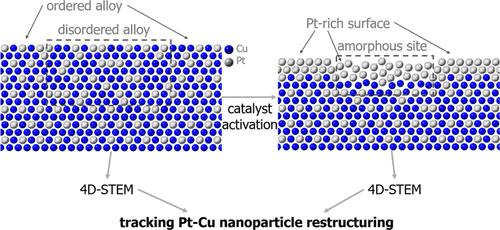使用同位四维扫描透射电子显微镜和无监督机器学习的pt合金纳米颗粒结构-稳定性关系
IF 16
1区 材料科学
Q1 CHEMISTRY, MULTIDISCIPLINARY
引用次数: 0
摘要
用于氧还原反应的纳米颗粒电催化剂是结构多样的材料。扫描透射电子显微镜(STEM)长期以来一直是获得纳米级结构高质量信息的首选工具。最近,它的四维模态已经成为使用大型衍射模式数据集进行全面晶体结构分析的工具。在这项研究中,我们追踪了单个碳负载的PtCu3纳米颗粒在燃料电池相关活化处理前后的晶体结构变化,包括温和的酸洗方案和电位循环,这对形成活性催化剂至关重要。为了充分利用丰富的、相同位置的4D-STEM功能,使用无监督算法进行复杂数据分析,从k-means聚类开始,然后是非负矩阵分解,以找到特定纳米颗粒数据中常见的信号。该研究揭示了具有(部分)有序合金结构、孪晶边界和局部非晶化的畴。活化后,纳米颗粒表面的特定位置显示出结晶度的损失,这可能与有序合金相的局部稀缺性有关,证实了有序合金在潜在循环活化条件下的稳定性增强。利用我们内部开发的相同位置4D-STEM方法来跟踪单个纳米颗粒的变化,结合先进的数据分析,我们确定了活化处理如何影响电催化剂的局部晶体结构。这种方法提供了相当丰富的见解,并且比传统的STEM成像对微小变化更加敏感。该工作流程需要很少的人工输入,具有合理的计算复杂性,并且可转移到其他功能纳米材料。本文章由计算机程序翻译,如有差异,请以英文原文为准。

Structure–Stability Relationships in Pt-Alloy Nanoparticles Using Identical-Location Four-Dimensional Scanning Transmission Electron Microscopy and Unsupervised Machine Learning
Nanoparticulate electrocatalysts for the oxygen reduction reaction are structurally diverse materials. Scanning transmission electron microscopy (STEM) has long been the go-to tool to obtain high-quality information about their nanoscale structure. More recently, its four-dimensional modality has emerged as a tool for a comprehensive crystal structure analysis using large data sets of diffraction patterns. In this study, we track the alternations of the crystal structure of individual carbon-supported PtCu3 nanoparticles before and after fuel cell-relevant activation treatment, consisting of a mild acid-washing protocol and potential cycling, essential for forming an active catalyst. To take full advantage of the rich, identical location 4D-STEM capabilities, unsupervised algorithms were used for the complex data analysis, starting with k-means clustering followed by non-negative matrix factorization, to find commonly occurring signals within specific nanoparticle data. The study revealed domains with (partially) ordered alloy structures, twin boundaries, and local amorphization. After activation, specific nanoparticle surface sites exhibited a loss of crystallinity which can be correlated to the simultaneous local scarcity of the ordered alloy phase, confirming the enhanced stability of the ordered alloy during potential cycling activation conditions. With the capabilities of our in-house developed identical-location 4D-STEM approach to track changes in individual nanoparticles, combined with advanced data analysis, we determine how activation treatment affects the electrocatalysts’ local crystal structure. Such an approach provides considerably richer insights and is much more sensitive to minor changes than traditional STEM imaging. This workflow requires little manual input, has a reasonable computational complexity, and is transferrable to other functional nanomaterials.
求助全文
通过发布文献求助,成功后即可免费获取论文全文。
去求助
来源期刊

ACS Nano
工程技术-材料科学:综合
CiteScore
26.00
自引率
4.10%
发文量
1627
审稿时长
1.7 months
期刊介绍:
ACS Nano, published monthly, serves as an international forum for comprehensive articles on nanoscience and nanotechnology research at the intersections of chemistry, biology, materials science, physics, and engineering. The journal fosters communication among scientists in these communities, facilitating collaboration, new research opportunities, and advancements through discoveries. ACS Nano covers synthesis, assembly, characterization, theory, and simulation of nanostructures, nanobiotechnology, nanofabrication, methods and tools for nanoscience and nanotechnology, and self- and directed-assembly. Alongside original research articles, it offers thorough reviews, perspectives on cutting-edge research, and discussions envisioning the future of nanoscience and nanotechnology.
 求助内容:
求助内容: 应助结果提醒方式:
应助结果提醒方式:


